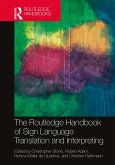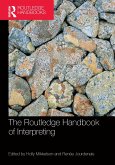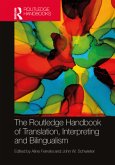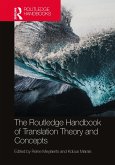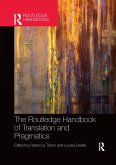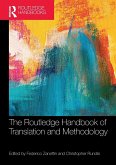The Routledge Handbook of Sign Language Translation and Interpreting
Herausgeber: Stone, Christopher; Müller de Quadros, Ronice; Adam, Robert
The Routledge Handbook of Sign Language Translation and Interpreting
Herausgeber: Stone, Christopher; Müller de Quadros, Ronice; Adam, Robert
- Broschiertes Buch
- Merkliste
- Auf die Merkliste
- Bewerten Bewerten
- Teilen
- Produkt teilen
- Produkterinnerung
- Produkterinnerung
This handbook provides the first comprehensive overview of Sign Language Translation and Interpretation from around the globe and looks ahead to future directions of research. This is the essential guide for advanced students and researchers of Translation and Interpretation studies and Sign Language.
Andere Kunden interessierten sich auch für
![The Routledge Handbook of Sign Language Translation and Interpreting The Routledge Handbook of Sign Language Translation and Interpreting]() The Routledge Handbook of Sign Language Translation and Interpreting246,99 €
The Routledge Handbook of Sign Language Translation and Interpreting246,99 €![The Routledge Handbook of Interpreting The Routledge Handbook of Interpreting]() The Routledge Handbook of Interpreting56,99 €
The Routledge Handbook of Interpreting56,99 €![The Routledge Handbook of Translation, Interpreting and Bilingualism The Routledge Handbook of Translation, Interpreting and Bilingualism]() The Routledge Handbook of Translation, Interpreting and Bilingualism48,99 €
The Routledge Handbook of Translation, Interpreting and Bilingualism48,99 €![The Routledge Handbook of Translation Theory and Concepts The Routledge Handbook of Translation Theory and Concepts]() The Routledge Handbook of Translation Theory and Concepts238,99 €
The Routledge Handbook of Translation Theory and Concepts238,99 €![The Routledge Handbook of Translation and Pragmatics The Routledge Handbook of Translation and Pragmatics]() The Routledge Handbook of Translation and Pragmatics50,99 €
The Routledge Handbook of Translation and Pragmatics50,99 €![The Routledge Handbook of Translation and Methodology The Routledge Handbook of Translation and Methodology]() The Routledge Handbook of Translation and Methodology62,99 €
The Routledge Handbook of Translation and Methodology62,99 €![The Routledge Handbook of Translation and Religion The Routledge Handbook of Translation and Religion]() The Routledge Handbook of Translation and Religion65,99 €
The Routledge Handbook of Translation and Religion65,99 €-
-
-
This handbook provides the first comprehensive overview of Sign Language Translation and Interpretation from around the globe and looks ahead to future directions of research. This is the essential guide for advanced students and researchers of Translation and Interpretation studies and Sign Language.
Produktdetails
- Produktdetails
- Routledge Handbooks in Translation and Interpreting Studies
- Verlag: Taylor & Francis Ltd
- Seitenzahl: 606
- Erscheinungstermin: 14. April 2025
- Englisch
- Abmessung: 246mm x 174mm x 32mm
- Gewicht: 1036g
- ISBN-13: 9781032281650
- ISBN-10: 1032281650
- Artikelnr.: 73496479
- Herstellerkennzeichnung
- Libri GmbH
- Europaallee 1
- 36244 Bad Hersfeld
- gpsr@libri.de
- Routledge Handbooks in Translation and Interpreting Studies
- Verlag: Taylor & Francis Ltd
- Seitenzahl: 606
- Erscheinungstermin: 14. April 2025
- Englisch
- Abmessung: 246mm x 174mm x 32mm
- Gewicht: 1036g
- ISBN-13: 9781032281650
- ISBN-10: 1032281650
- Artikelnr.: 73496479
- Herstellerkennzeichnung
- Libri GmbH
- Europaallee 1
- 36244 Bad Hersfeld
- gpsr@libri.de
Christopher Stone is a reader in Interpreting and Translation and course leader of the MA in Interpreting at the University of Wolverhampton, UK. He serves on the advisory board of the journal Interpreting and is the current president of the World Association of Sign Language Interpreters. Robert Adam is an assistant professor in Languages and Intercultural Studies at the Centre for Translation and Interpreting Studies in Scotland, Heriot-Watt University, Edinburgh, Scotland. Ronice Müller de Quadros is a full professor at the Federal University of Santa Catarina in Brazil. Christian Rathmann is a professor in Interpreting at the Humboldt-Universität zu Berlin, Germany, and is a certified interpreter and translator.
List of Contributors
Introduction
Christopher Stone, Robert Adam, Ronice Müller de Quadros, Christian
Rathmann
Part 1 Cognitive processes and theoretical foundations
1. Multimodal-multilingual interpreting: Signed-spoken interactions
Rafael Treviño, Ricardo Ortiz, David Quinto-Pozos
2. Interpreting aptitude
Christopher Stone
3. Directionality in translation and interpreting
Jihong Wang
Part 2 Sign language translation
4. A history of Deaf and hearing interpreters in France from the high
Middle Ages to the present day
Yann Cantique, Florence Encrevé
5. Media team interpreting: A new support role arising
Laura Astrada, Gabriel Andrés Claria
6. Sign language translation: Team translation
Corinna Brenner, Sina Gloyer, Okan Kubus, Benedikt Sequeira Gerardo, Svenja
Wurm
Part 3 Sign language interpreting
7. A history of interpreting in deaf communities
Robert Adam
8. Intersectionality of the sign language interpreting identity: An African
perspective
Natasha Parkins-Maliko
9. Media and emergency interpreting
Christopher Stone, Debra Russell
10. Team interpreting
Jack Hoza
Part 4 Sign language translation and interpreting education
11. Translation as a pedagogical tool
Sarah Sheridan, Teresa Lynch
12. Discourse analysis to develop interpreting and translation competency
Betsy Winston, Cynthia Roy
13. Wait now, let me think: Consecutive interpreting revisited
Debra Russell, Jeanette Nicholson
14. The intermodal simultaneous interpreting process
Carlos Henrique Rodrigues
Part 5 The politics of translation, interpreting, and service delivery
15. Developing Deaf jurisprudence: The role of interpreters and translators
Rob Wilks
16. The trajectory of the deaf interpreter and translator on International
Sign Language: Lessons from Juan Carlos Druetta in South America
Kátia Lucy Pinheiro, Marianne Rossi Stumpf
17. Challenges in the professionalisation of sign language interpreting in
Uganda
Sam Lutalo-Kiingi, John Buyinza, Goedele A.M. De Clerck, Graham H. Turner
18. Deaf profession/designated interpreter paradigm revisited
Peter C. Hauser, Nikki Cherry, Angela B. Hauser, Mala S. Poe
19. The interpreting team: The integration of strategies used during the
interpreting process in the booth
Tiago Coimbra Nogueira
Part 6 Public service settings
20. Interpreting in the clinical setting: Deaf patients and access to
healthcare in the US
Laurie R. Shaffer
21. Collaboration: Sign language interpreters and clinicians working
together in mental health settings
Steve H. Hamerdinger, Charlene J. Crump
22. Interpreting in police settings
Robert Skinner, Eloisa Monteoliva
23. Courtroom interpreting: Creating access for linguistic minorities
Jeremy L. Brunson, LeWana Clark, Christopher Tester
24. An overview of Libras-Portuguese translation and interpretation in the
legal sphere
Silvana Aguiar dos Santos, Marianne Rossi Stumpf
Part 7 Diverse linguistic-cultural deaf communities
25. Diverse challenges for deaf migrants when navigating Nordic countries
Ingela Holmström, Ninva Sivunen
26. Interpreting for Deaf children
Kim B. Kurz
27. Translation policies for the education of sign language translators and
interpreters in school environments
Sonia Marta de Oliveira, Ronice Müller de Quadros
28. The provision of sign language interpretation in Asia
Felix Sze, Fion Wong, Connie Lo, Samuel Chew, Rebecca Sun, Yuya Yanai
Part 8 Current status of interpreting and translation
29. Sign language interpretation training, testing, and accreditation in
Asia
Felix Sze, Fion Wong, Connie Lo, Samuel Chew, Rebecca Sun, Yuya Yanai
30. The state of sign language interpreting and interpreters in the Arab
world: an exploratory study
Sameer Mohammad Yahya Samreen
31. The state of sign language translation and interpreting in the East
Africa community
Bonnie Busingye, Nantongo Proscovia Suubi
32. Sign language interpreting in Russia and neighbouring countries (the
EECAC)
Anna Komarova
33. Sign language interpreting within a North America context
Campbell Mcdermid, Leandra Williams, Eduardo Daniel Maya Ortega
Index
Introduction
Christopher Stone, Robert Adam, Ronice Müller de Quadros, Christian
Rathmann
Part 1 Cognitive processes and theoretical foundations
1. Multimodal-multilingual interpreting: Signed-spoken interactions
Rafael Treviño, Ricardo Ortiz, David Quinto-Pozos
2. Interpreting aptitude
Christopher Stone
3. Directionality in translation and interpreting
Jihong Wang
Part 2 Sign language translation
4. A history of Deaf and hearing interpreters in France from the high
Middle Ages to the present day
Yann Cantique, Florence Encrevé
5. Media team interpreting: A new support role arising
Laura Astrada, Gabriel Andrés Claria
6. Sign language translation: Team translation
Corinna Brenner, Sina Gloyer, Okan Kubus, Benedikt Sequeira Gerardo, Svenja
Wurm
Part 3 Sign language interpreting
7. A history of interpreting in deaf communities
Robert Adam
8. Intersectionality of the sign language interpreting identity: An African
perspective
Natasha Parkins-Maliko
9. Media and emergency interpreting
Christopher Stone, Debra Russell
10. Team interpreting
Jack Hoza
Part 4 Sign language translation and interpreting education
11. Translation as a pedagogical tool
Sarah Sheridan, Teresa Lynch
12. Discourse analysis to develop interpreting and translation competency
Betsy Winston, Cynthia Roy
13. Wait now, let me think: Consecutive interpreting revisited
Debra Russell, Jeanette Nicholson
14. The intermodal simultaneous interpreting process
Carlos Henrique Rodrigues
Part 5 The politics of translation, interpreting, and service delivery
15. Developing Deaf jurisprudence: The role of interpreters and translators
Rob Wilks
16. The trajectory of the deaf interpreter and translator on International
Sign Language: Lessons from Juan Carlos Druetta in South America
Kátia Lucy Pinheiro, Marianne Rossi Stumpf
17. Challenges in the professionalisation of sign language interpreting in
Uganda
Sam Lutalo-Kiingi, John Buyinza, Goedele A.M. De Clerck, Graham H. Turner
18. Deaf profession/designated interpreter paradigm revisited
Peter C. Hauser, Nikki Cherry, Angela B. Hauser, Mala S. Poe
19. The interpreting team: The integration of strategies used during the
interpreting process in the booth
Tiago Coimbra Nogueira
Part 6 Public service settings
20. Interpreting in the clinical setting: Deaf patients and access to
healthcare in the US
Laurie R. Shaffer
21. Collaboration: Sign language interpreters and clinicians working
together in mental health settings
Steve H. Hamerdinger, Charlene J. Crump
22. Interpreting in police settings
Robert Skinner, Eloisa Monteoliva
23. Courtroom interpreting: Creating access for linguistic minorities
Jeremy L. Brunson, LeWana Clark, Christopher Tester
24. An overview of Libras-Portuguese translation and interpretation in the
legal sphere
Silvana Aguiar dos Santos, Marianne Rossi Stumpf
Part 7 Diverse linguistic-cultural deaf communities
25. Diverse challenges for deaf migrants when navigating Nordic countries
Ingela Holmström, Ninva Sivunen
26. Interpreting for Deaf children
Kim B. Kurz
27. Translation policies for the education of sign language translators and
interpreters in school environments
Sonia Marta de Oliveira, Ronice Müller de Quadros
28. The provision of sign language interpretation in Asia
Felix Sze, Fion Wong, Connie Lo, Samuel Chew, Rebecca Sun, Yuya Yanai
Part 8 Current status of interpreting and translation
29. Sign language interpretation training, testing, and accreditation in
Asia
Felix Sze, Fion Wong, Connie Lo, Samuel Chew, Rebecca Sun, Yuya Yanai
30. The state of sign language interpreting and interpreters in the Arab
world: an exploratory study
Sameer Mohammad Yahya Samreen
31. The state of sign language translation and interpreting in the East
Africa community
Bonnie Busingye, Nantongo Proscovia Suubi
32. Sign language interpreting in Russia and neighbouring countries (the
EECAC)
Anna Komarova
33. Sign language interpreting within a North America context
Campbell Mcdermid, Leandra Williams, Eduardo Daniel Maya Ortega
Index
List of Contributors
Introduction
Christopher Stone, Robert Adam, Ronice Müller de Quadros, Christian
Rathmann
Part 1 Cognitive processes and theoretical foundations
1. Multimodal-multilingual interpreting: Signed-spoken interactions
Rafael Treviño, Ricardo Ortiz, David Quinto-Pozos
2. Interpreting aptitude
Christopher Stone
3. Directionality in translation and interpreting
Jihong Wang
Part 2 Sign language translation
4. A history of Deaf and hearing interpreters in France from the high
Middle Ages to the present day
Yann Cantique, Florence Encrevé
5. Media team interpreting: A new support role arising
Laura Astrada, Gabriel Andrés Claria
6. Sign language translation: Team translation
Corinna Brenner, Sina Gloyer, Okan Kubus, Benedikt Sequeira Gerardo, Svenja
Wurm
Part 3 Sign language interpreting
7. A history of interpreting in deaf communities
Robert Adam
8. Intersectionality of the sign language interpreting identity: An African
perspective
Natasha Parkins-Maliko
9. Media and emergency interpreting
Christopher Stone, Debra Russell
10. Team interpreting
Jack Hoza
Part 4 Sign language translation and interpreting education
11. Translation as a pedagogical tool
Sarah Sheridan, Teresa Lynch
12. Discourse analysis to develop interpreting and translation competency
Betsy Winston, Cynthia Roy
13. Wait now, let me think: Consecutive interpreting revisited
Debra Russell, Jeanette Nicholson
14. The intermodal simultaneous interpreting process
Carlos Henrique Rodrigues
Part 5 The politics of translation, interpreting, and service delivery
15. Developing Deaf jurisprudence: The role of interpreters and translators
Rob Wilks
16. The trajectory of the deaf interpreter and translator on International
Sign Language: Lessons from Juan Carlos Druetta in South America
Kátia Lucy Pinheiro, Marianne Rossi Stumpf
17. Challenges in the professionalisation of sign language interpreting in
Uganda
Sam Lutalo-Kiingi, John Buyinza, Goedele A.M. De Clerck, Graham H. Turner
18. Deaf profession/designated interpreter paradigm revisited
Peter C. Hauser, Nikki Cherry, Angela B. Hauser, Mala S. Poe
19. The interpreting team: The integration of strategies used during the
interpreting process in the booth
Tiago Coimbra Nogueira
Part 6 Public service settings
20. Interpreting in the clinical setting: Deaf patients and access to
healthcare in the US
Laurie R. Shaffer
21. Collaboration: Sign language interpreters and clinicians working
together in mental health settings
Steve H. Hamerdinger, Charlene J. Crump
22. Interpreting in police settings
Robert Skinner, Eloisa Monteoliva
23. Courtroom interpreting: Creating access for linguistic minorities
Jeremy L. Brunson, LeWana Clark, Christopher Tester
24. An overview of Libras-Portuguese translation and interpretation in the
legal sphere
Silvana Aguiar dos Santos, Marianne Rossi Stumpf
Part 7 Diverse linguistic-cultural deaf communities
25. Diverse challenges for deaf migrants when navigating Nordic countries
Ingela Holmström, Ninva Sivunen
26. Interpreting for Deaf children
Kim B. Kurz
27. Translation policies for the education of sign language translators and
interpreters in school environments
Sonia Marta de Oliveira, Ronice Müller de Quadros
28. The provision of sign language interpretation in Asia
Felix Sze, Fion Wong, Connie Lo, Samuel Chew, Rebecca Sun, Yuya Yanai
Part 8 Current status of interpreting and translation
29. Sign language interpretation training, testing, and accreditation in
Asia
Felix Sze, Fion Wong, Connie Lo, Samuel Chew, Rebecca Sun, Yuya Yanai
30. The state of sign language interpreting and interpreters in the Arab
world: an exploratory study
Sameer Mohammad Yahya Samreen
31. The state of sign language translation and interpreting in the East
Africa community
Bonnie Busingye, Nantongo Proscovia Suubi
32. Sign language interpreting in Russia and neighbouring countries (the
EECAC)
Anna Komarova
33. Sign language interpreting within a North America context
Campbell Mcdermid, Leandra Williams, Eduardo Daniel Maya Ortega
Index
Introduction
Christopher Stone, Robert Adam, Ronice Müller de Quadros, Christian
Rathmann
Part 1 Cognitive processes and theoretical foundations
1. Multimodal-multilingual interpreting: Signed-spoken interactions
Rafael Treviño, Ricardo Ortiz, David Quinto-Pozos
2. Interpreting aptitude
Christopher Stone
3. Directionality in translation and interpreting
Jihong Wang
Part 2 Sign language translation
4. A history of Deaf and hearing interpreters in France from the high
Middle Ages to the present day
Yann Cantique, Florence Encrevé
5. Media team interpreting: A new support role arising
Laura Astrada, Gabriel Andrés Claria
6. Sign language translation: Team translation
Corinna Brenner, Sina Gloyer, Okan Kubus, Benedikt Sequeira Gerardo, Svenja
Wurm
Part 3 Sign language interpreting
7. A history of interpreting in deaf communities
Robert Adam
8. Intersectionality of the sign language interpreting identity: An African
perspective
Natasha Parkins-Maliko
9. Media and emergency interpreting
Christopher Stone, Debra Russell
10. Team interpreting
Jack Hoza
Part 4 Sign language translation and interpreting education
11. Translation as a pedagogical tool
Sarah Sheridan, Teresa Lynch
12. Discourse analysis to develop interpreting and translation competency
Betsy Winston, Cynthia Roy
13. Wait now, let me think: Consecutive interpreting revisited
Debra Russell, Jeanette Nicholson
14. The intermodal simultaneous interpreting process
Carlos Henrique Rodrigues
Part 5 The politics of translation, interpreting, and service delivery
15. Developing Deaf jurisprudence: The role of interpreters and translators
Rob Wilks
16. The trajectory of the deaf interpreter and translator on International
Sign Language: Lessons from Juan Carlos Druetta in South America
Kátia Lucy Pinheiro, Marianne Rossi Stumpf
17. Challenges in the professionalisation of sign language interpreting in
Uganda
Sam Lutalo-Kiingi, John Buyinza, Goedele A.M. De Clerck, Graham H. Turner
18. Deaf profession/designated interpreter paradigm revisited
Peter C. Hauser, Nikki Cherry, Angela B. Hauser, Mala S. Poe
19. The interpreting team: The integration of strategies used during the
interpreting process in the booth
Tiago Coimbra Nogueira
Part 6 Public service settings
20. Interpreting in the clinical setting: Deaf patients and access to
healthcare in the US
Laurie R. Shaffer
21. Collaboration: Sign language interpreters and clinicians working
together in mental health settings
Steve H. Hamerdinger, Charlene J. Crump
22. Interpreting in police settings
Robert Skinner, Eloisa Monteoliva
23. Courtroom interpreting: Creating access for linguistic minorities
Jeremy L. Brunson, LeWana Clark, Christopher Tester
24. An overview of Libras-Portuguese translation and interpretation in the
legal sphere
Silvana Aguiar dos Santos, Marianne Rossi Stumpf
Part 7 Diverse linguistic-cultural deaf communities
25. Diverse challenges for deaf migrants when navigating Nordic countries
Ingela Holmström, Ninva Sivunen
26. Interpreting for Deaf children
Kim B. Kurz
27. Translation policies for the education of sign language translators and
interpreters in school environments
Sonia Marta de Oliveira, Ronice Müller de Quadros
28. The provision of sign language interpretation in Asia
Felix Sze, Fion Wong, Connie Lo, Samuel Chew, Rebecca Sun, Yuya Yanai
Part 8 Current status of interpreting and translation
29. Sign language interpretation training, testing, and accreditation in
Asia
Felix Sze, Fion Wong, Connie Lo, Samuel Chew, Rebecca Sun, Yuya Yanai
30. The state of sign language interpreting and interpreters in the Arab
world: an exploratory study
Sameer Mohammad Yahya Samreen
31. The state of sign language translation and interpreting in the East
Africa community
Bonnie Busingye, Nantongo Proscovia Suubi
32. Sign language interpreting in Russia and neighbouring countries (the
EECAC)
Anna Komarova
33. Sign language interpreting within a North America context
Campbell Mcdermid, Leandra Williams, Eduardo Daniel Maya Ortega
Index



